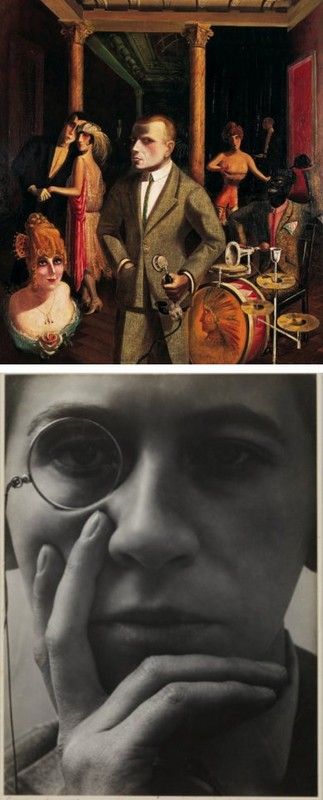New Objectivity
04 Oct 2015 - 18 Jan 2016

Upper Image: Otto Dix, To Beauty (An die Schönheit), 1922, oil and collage on canvas, Von der Heydt-Museum Wuppertal, Germany, © 2015 Artists Rights Society (ARS), New York/VG Bild-Kunst, Bonn, photo courtesy Von der Heydt-Museum Wuppertal, Germany.
Lower Image: Aenne Biermann, Woman with Monocle (Dame mit Monokel), c. 1928, gelatin silver print, Pinakothek der Moderne, Munich/Stiftung Ann und Jürgen Wilde, photo: Bayerische Staatsgemäldesammlungen, Fotoarchiv.
Lower Image: Aenne Biermann, Woman with Monocle (Dame mit Monokel), c. 1928, gelatin silver print, Pinakothek der Moderne, Munich/Stiftung Ann und Jürgen Wilde, photo: Bayerische Staatsgemäldesammlungen, Fotoarchiv.
NEW OBJECTIVITY
Modern German Art in the Weimar Republic, 1919–1933
4 October 2015 – 18 January 2016
Germany’s Weimar Republic, established between the end of World War I and the Nazi rise to power, was a thriving laboratory of art and culture. As the country experienced unprecedented and often tumultuous social, economic, and political upheaval, many artists rejected Expressionism in favor of a new realism to capture this emerging society. Dubbed Neue Sachlichkeit—New Objectivity—its adherents turned a cold eye on the new Germany: its desperate prostitutes, crippled war veterans, and alienated urban landscapes, but also its emancipated New Woman, modern architecture, and mass-produced commodities.
New Objectivity: Modern German Art in the Weimar Republic, 1919–1933 is the first comprehensive exhibition in the United States to explore the dominant artistic trends of this period. Organized around five thematic sections and featuring 180 works by more than 50 artists, the exhibition mixes painting, photography, and works on paper to bring them into a visual dialogue. Key figures of modernism, such as Max Beckmann, Otto Dix, George Grosz, August Sander, and Christian Schad are featured alongside lesser-known artists such as Aenne Biermann, Heinrich Maria Davringhausen, Hans Finsler, Carl Grossberg, Lotte Jacobi, Alexander Kanoldt, and Georg Schrimpf.
Modern German Art in the Weimar Republic, 1919–1933
4 October 2015 – 18 January 2016
Germany’s Weimar Republic, established between the end of World War I and the Nazi rise to power, was a thriving laboratory of art and culture. As the country experienced unprecedented and often tumultuous social, economic, and political upheaval, many artists rejected Expressionism in favor of a new realism to capture this emerging society. Dubbed Neue Sachlichkeit—New Objectivity—its adherents turned a cold eye on the new Germany: its desperate prostitutes, crippled war veterans, and alienated urban landscapes, but also its emancipated New Woman, modern architecture, and mass-produced commodities.
New Objectivity: Modern German Art in the Weimar Republic, 1919–1933 is the first comprehensive exhibition in the United States to explore the dominant artistic trends of this period. Organized around five thematic sections and featuring 180 works by more than 50 artists, the exhibition mixes painting, photography, and works on paper to bring them into a visual dialogue. Key figures of modernism, such as Max Beckmann, Otto Dix, George Grosz, August Sander, and Christian Schad are featured alongside lesser-known artists such as Aenne Biermann, Heinrich Maria Davringhausen, Hans Finsler, Carl Grossberg, Lotte Jacobi, Alexander Kanoldt, and Georg Schrimpf.
